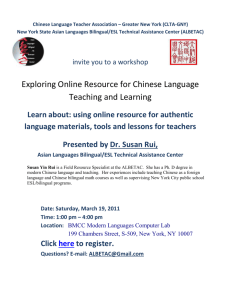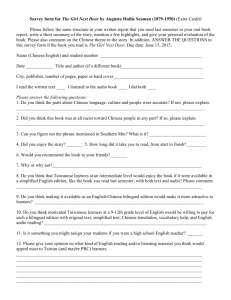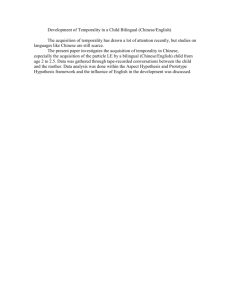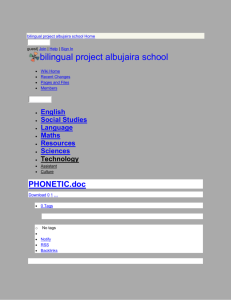Document 14093612
advertisement
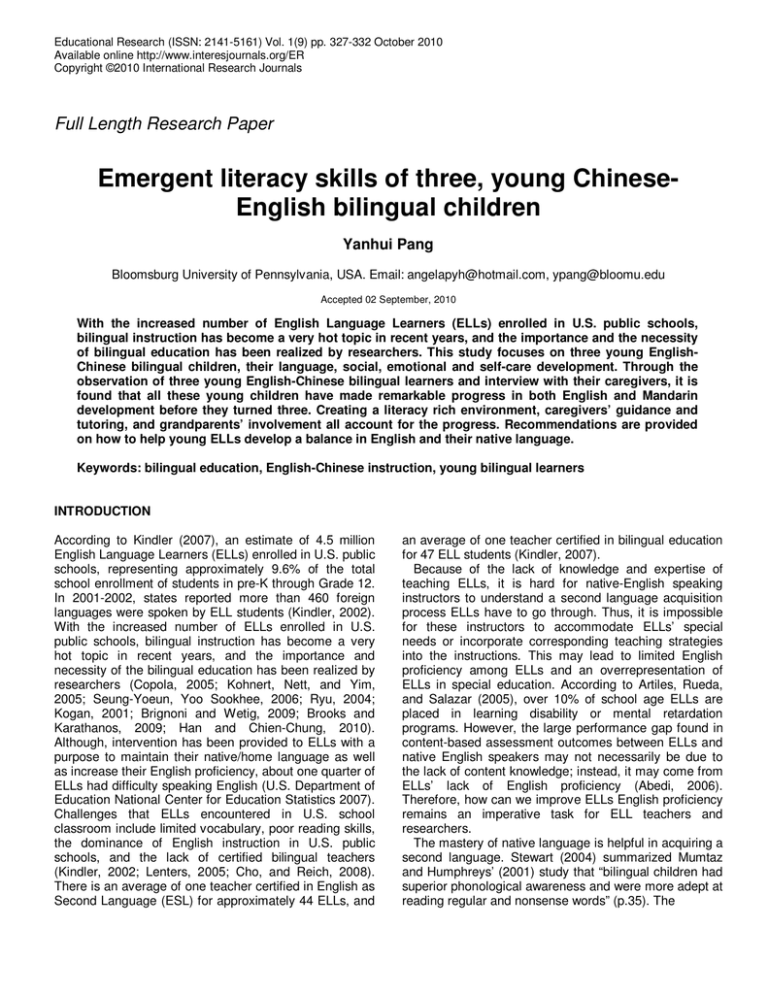
Educational Research (ISSN: 2141-5161) Vol. 1(9) pp. 327-332 October 2010 Available online http://www.interesjournals.org/ER Copyright ©2010 International Research Journals Full Length Research Paper Emergent literacy skills of three, young ChineseEnglish bilingual children Yanhui Pang Bloomsburg University of Pennsylvania, USA. Email: angelapyh@hotmail.com, ypang@bloomu.edu Accepted 02 September, 2010 With the increased number of English Language Learners (ELLs) enrolled in U.S. public schools, bilingual instruction has become a very hot topic in recent years, and the importance and the necessity of bilingual education has been realized by researchers. This study focuses on three young EnglishChinese bilingual children, their language, social, emotional and self-care development. Through the observation of three young English-Chinese bilingual learners and interview with their caregivers, it is found that all these young children have made remarkable progress in both English and Mandarin development before they turned three. Creating a literacy rich environment, caregivers’ guidance and tutoring, and grandparents’ involvement all account for the progress. Recommendations are provided on how to help young ELLs develop a balance in English and their native language. Keywords: bilingual education, English-Chinese instruction, young bilingual learners INTRODUCTION According to Kindler (2007), an estimate of 4.5 million English Language Learners (ELLs) enrolled in U.S. public schools, representing approximately 9.6% of the total school enrollment of students in pre-K through Grade 12. In 2001-2002, states reported more than 460 foreign languages were spoken by ELL students (Kindler, 2002). With the increased number of ELLs enrolled in U.S. public schools, bilingual instruction has become a very hot topic in recent years, and the importance and necessity of the bilingual education has been realized by researchers (Copola, 2005; Kohnert, Nett, and Yim, 2005; Seung-Yoeun, Yoo Sookhee, 2006; Ryu, 2004; Kogan, 2001; Brignoni and Wetig, 2009; Brooks and Karathanos, 2009; Han and Chien-Chung, 2010). Although, intervention has been provided to ELLs with a purpose to maintain their native/home language as well as increase their English proficiency, about one quarter of ELLs had difficulty speaking English (U.S. Department of Education National Center for Education Statistics 2007). Challenges that ELLs encountered in U.S. school classroom include limited vocabulary, poor reading skills, the dominance of English instruction in U.S. public schools, and the lack of certified bilingual teachers (Kindler, 2002; Lenters, 2005; Cho, and Reich, 2008). There is an average of one teacher certified in English as Second Language (ESL) for approximately 44 ELLs, and an average of one teacher certified in bilingual education for 47 ELL students (Kindler, 2007). Because of the lack of knowledge and expertise of teaching ELLs, it is hard for native-English speaking instructors to understand a second language acquisition process ELLs have to go through. Thus, it is impossible for these instructors to accommodate ELLs’ special needs or incorporate corresponding teaching strategies into the instructions. This may lead to limited English proficiency among ELLs and an overrepresentation of ELLs in special education. According to Artiles, Rueda, and Salazar (2005), over 10% of school age ELLs are placed in learning disability or mental retardation programs. However, the large performance gap found in content-based assessment outcomes between ELLs and native English speakers may not necessarily be due to the lack of content knowledge; instead, it may come from ELLs’ lack of English proficiency (Abedi, 2006). Therefore, how can we improve ELLs English proficiency remains an imperative task for ELL teachers and researchers. The mastery of native language is helpful in acquiring a second language. Stewart (2004) summarized Mumtaz and Humphreys’ (2001) study that “bilingual children had superior phonological awareness and were more adept at reading regular and nonsense words” (p.35). The 328 Educ. Res. phonological awareness in native language “can be transferred and generalized into a second language” (Stewart, 2004, p.35). Lenters (2005) summarized the previous studies on bilingual education and concluded that bilingual education will promote significant cognitive gains in young children and the gains however, “are only experienced when both languages develop to a point of proficiency where transfer can take place between the two” (Lenters, 2005, Theoretical framework, para. 4). In considering bilingual education, the first issue is when and how to provide the bilingual education to ELL students. Although the advantages of learning two languages from birth have been recognized by researchers (Genesee et al., 2004; Han and ChienChung, 2010), not every ELL is exposed to bilingual education from that early, while many start to learn English at school. For ELLs who are not exposed to English until school age, several factors contribute to a child’s opportunity to be proficient in both English and their native language, such as the access to speakers of each language, family decisions about the use of each language, and the role of each language in the community and school (Coppola, 2005). Parents can play a major role in promoting bilingual education by tutoring and balancing English and native language instruction and providing a literacy rich environment (Ryu, 2004). METHOD This study focuses on the three two-and- a-half-year-old Chinese children who were born in the U.S., and their bilingual education. The study was conducted through observation and interviews with the parents and grandparents. One-hour observations of children’s play and their interaction with same-age peers took place every week for six months. The observations were conducted mostly in the child’s home, but sometime occurred at the community settings such as the park and the swimming pool. The caregivers were interviewed of their bilingual pedagogies, the time spent on either of the two-language instruction, bilingual activities their children were involved in, and family involvement in bilingual instruction. Case I—Henry’s Bilingual Education and the Overall Development The first child, named Henry, is two-and-a-half-year old. He is the only child in his family. His mother holds a doctorate degree in early childhood education and is currently a university professor. His father went back to China one year after Henry was born and comes back to visit him and her mother periodically. His grandparents stay with them for a couple of years. Henry’s mother provides him a literacy rich environment at home. She purchases books, videotapes of his interests such as Thomas the Train, Big Bird Sings, Teletubbies, Mother Goose, ABC songs, etc., and games in both English and Chinese. The mother started to teach him in both languages from birth. She talked to him and answered his questions in both the two languages, and she read to him in both languages alternatively. For example, on Monday, Wednesday and Friday, she reads to him in English, while on Tuesday, Thursday and Saturday she reads to him in Chinese for about half an hour every evening. On Sundays she takes Henry to the public library in town and joins the reading program there with other children of the similar age. Now at age two-and-a-half, he can retell three storybooks by himself in both English and Chinese by looking at the illustrations. Henry stays with his grandparents during weekdays when his mother is at work; as Henry’s grandparents do not speak English, his mother talks to him in English only when she is off work. She also plays some games to help him learn and practice English. For example, one of Henry’s favorite games is ABC game: there are twenty eight word cards in this game and all the cards have first letters missed. The player is supposed to find the correct alphabet letter and attach it to each word. At beginning, Henry’s mother will spell the word and read the word for Henry. She then prompts him to look for correct letters and match them to the corresponding words. Later on, when Henry learns all twenty-six words, he imitates mother at the game. First he spells the letters in each word and reads the word first, and then he looks for the correct letters that match the word. He learns the capitalized alphabet letters from this game. He can name all twenty-six alphabet letters, sequence them, and use them to make simple words. He also learns the lower case alphabet letters from another game—word puzzle game. His writing skills are reinforced by the easel his mother purchased for him when he was two years old. By two-and-a-half, he can write numbers from one to five and letters A, B, and C with some assistance. He also learns to sing nursery songs in both English and Chinese. Henry is a very precocious child; he has approximately 200 English words in his expressive language and a minimum of 350 English words in his receptive language by age two-and-a-half. His also achieves satisfactory development in Chinese as he can understand and use most of the daily used phrases such as “time to eat”, “grocery shopping for egg, yogurt, banana, vegetable”, “clean up”, “go to bed, go take a shower”, etc. His receptive language in Chinese was estimated as roughly 300 words, and his expressive language in Chinese is 100 words by two and half years old. Henry’s mother also teaches him mathematical skills such as counting and simple addition problems in both English and Chinese. He now can count to fifty and can do the one to five addition problems using either of the two languages. He shows an interest in science through the world map puzzle. At two he can put the fifty-state Pang 329 puzzle pieces together on a U.S. map independently, and figures out and places all the province puzzle pieces together on a China’s map with some verbal instructions. He also learns the main agricultural or industrial product in some states/provinces from this game. Although, Henry has not been enrolled in school yet, whenever there is any community activities for young children, his mother will bring him there. Henry also participates in a bible study program in a local Chinese community, where he meets and plays with other Chinese children once a week. He learns some social rules of turn taking, sharing, sitting quietly during story time, and pays attention to Sunday school teachers’ lecture. He shows his affection when other children are not feeling well or sad at their parents’ leave. He shares his favorite toy, Thomas the Train with them when that happens. Henry has been potty trained since 18 months and he hasn’t worn dippers since then except night, and he can go potty all by himself. He like to help with some daily housework like carrying grocery bags, setting the table, and cleaning up toys after he is done with them. Interview with Caregivers Henry’s mother is a special education professor with a concentration in early childhood. She knows well the young children’s development milestone and the interdependence of the cognitive, language, social and emotional, self-care, and gross and fine motor skills. She balances Henry’s time in reading, writing, playing game, physical activities such as soccer time, tricycle/bicycle time, and playing with peers in their community. She also balances her son’s time in Chinese and English learning every day; she expects that he can be fluent in both of the two languages. The grandparents, who stayed with them periodically showed their concerns of losing Chinese skills when Henry goes to school, for they heard stories that many second-generation immigrants from China are incapable of communicating in Chinese after they went to English-only school in the U.S. Therefore, Henry’s grandparents spent more time reinforcing their grandson’s Chinese language skills when they are around. Henry’s mother is very optimistic of her son’s language ability and the education plan designed for her son. She said she will consistently tutor her son in both languages until he can master and speak fluently in both languages. Case II—Alex’s Bilingual Education and His Overall Development Alex is one month older than Henry. Born in U.S. as well, Alex was sent back to China when he was two months old and stayed with his grandparents in a small town in southwestern China until he was two years old. When he first came back, Alex only spoke in Sichun dialect, a dialect of Mandarin, and knew little English. His father holds a doctorate degree and is a university professor teaching technology and his mother stays at home with him and his two-month-old baby sister. Although not enrolled in school, Alex also lives in a good literacy environment. Alex’s parents bought him lots of children’s books in both Chinese and English, and also purchased him videotapes in both languages. As Alex’s English is pretty limited, his parents talks to him more in English and read English books for him at home; while his grandmother, who stays with them temporarily and doesn’t know English at all, talks to him only in Chinese. Alex catches up very quickly in English. By the third month after he came back to the U.S., he can understand and follow the simple commands in English, such as “go to bed”, “time to change dipper for your baby sister”, “time to go outside and play”, “continue to read”, “open the door”, “sit on your bottom”, etc. By two-and-a-half years old, his mother estimated that he has a receptive language of 200 words in English, although his expressive language in English is still very limited. He can express his feelings using words as sad, tired, hungry, and he likes to imitate what he learned from the videotapes such as “Elmo says”. His Chinese language skills still outpaced his English skills with about 300 words in his receptive language in Chinese and 150 words in expressive language in Chinese. Similar to Henry, although Alex has not been enrolled in school yet, his parents brought him to attend community activities for young children as much as possible. Alex has a hard time sharing and taking turns with other children at play. He likes to have what others are playing with. Most of the time, he is the trouble maker, who takes away the toys or suddenly knocks over his peers. He cannot sit still or quietly for a minute; he likes to run around during the group activities like story time. According to the observation, although his parents are very concerned about his manners and behaviors at home, they haven’t found any effective method to manage his behavior problems yet. When Alex makes trouble or has a temper tantrum, most of the time the parents give him a time out letting him stay alone in his room for ten minutes regardless his screams or tantrums. However, it ends up with Alex’s grandmother rescuing him without letting his father know. So, obviously, the time out itself doesn’t really work in Alex’s case. Since Alex was raised in china with his grandparents and it is not common to use diapers in China’s small towns, Alex has been potty trained very early and he rarely wears diapers. He also learns to eat by himself, and is taught to do simple work for his baby sister, such as getting and disposing diaper for her, getting a bottle for her, etc. as in Chinese culture, it is recommended that older siblings care for the younger ones. 330 Educ. Res. Caregivers’ Interview Both Alex’s parents believe in the importance of bilingual education and they said they will try their best to create a good educational setting for their son and daughter. They spend some time watching TV together with their son and answering his questions if he has some. The mother shows concerns that Alex spends more than two hours daily watching TV. They do not limit his TV time since they believe TV watching can improve Alex’s English listening skills. The parents didn’t mention any concern of Alex’s behavior issues or lack of social, emotional skills. This is not unusual in Chinese parents, who focus more on the academic development rather than social interaction skills. Case III—Jennifer’s Bilingual Education and Her Overall Development Jennifer, seventeen days older than Henry, was also born in U.S. She is the only child in her family. Both of her parents hold a master degree in computer science. Different from Henry and Alex, Jennifer was enrolled in a childcare program right after birth. Her language skills are more advanced than those of Henry and Alex. For example at two she had already recited two Chinese poems, sung two English nursery songs, named the simple objects such as table, chairs, cups, butterfly, horse, etc. in both English and Chinese, as well as told simple stories in both Chinese and English. By two-anda-half, she can sing an ABC song and several other nursery songs pretty well in both the two languages. She can understand very well in the two languages as well. Although her language skills are well developed at twoand-a-half, her cognitive skills seem behind Henry. She still plays very simple puzzle games. With assistance she can count from one to ten, but she cannot do any simple addition problem “because she was not exposed to”, mentioned by the mother. She cannot name the twentysix alphabet letters although she can sing the alphabet songs. She can turn pages when read to and point to the pictures when her parents name the objects or animals in books. Enrolled in a daycare center since six-month old, Jennifer knows all of the class rules although she may violate some occasionally. For example, she is always the first who takes her socks off without permission. She is the one who sings and disturbs others during nap time. It is also she who shares her sippy cup with other children although her teachers keep mentioning it is not allowed. Most of the time, she is a good child and follows the class rules. She takes turns, sits quietly and listens to the teacher attentively during story time, and shares her teddy bear with friends when they are sad or not feeling well. She loves to hold her baby doll sitting on the rocking chair in school. When she is temporarily placed in infant room for half an hour as her mother sometimes come late to pick her up, Jennifer likes to take care of babies; there, she hands them toys and pat them to sleep. She has not been potty trained yet, so she has to wear diapers all the time. She does not participate in simple household tasks as Henry and Alex. Interview with the Caregivers Jennifer’s parents mentioned that they sent her to school to learn English because they are afraid that she will be lagged behind if she is not exposed to English from an early age. Both Jennifer’s parents are very busy at work and they couldn’t find time to teach her English at home. The grandparents, who come to visit them periodically, also share the similar concern about Jennifer’s English language development. Since Jennifer is enrolled in daycare, where she is exposed to English all day long, her parents and grandparents talk to her more in Chinese at home. They also bought her many children’s books and videotapes in Chinese. But, they seldom expressed any concerns with Jennifer’s Chinese language development, for they believe that Jennifer will naturally pick up the Chinese since everybody speaks in Chinese at home. Plus, Jennifer is brought back to visit China once a year, this way she can build up a bonding with her native culture and learn Chinese. DISCUSSION The three participating families believe in bilingual instruction: all these three children are immersed in both English and Chinese environment. All these three families want their children to be bilingual and have figured out their own bilingual instruction approach. All of them have grandparents involved in their children’s growth as in Chinese culture grandparents share responsibilities of raising and educating the grandchildren. Yet, differences exist among these three Chinese immigrant families. Henry’s mother as an early childhood specialist has expertise in educating young children and applies recommended philosophies and pedagogies to teach her son, while the grandparents mainly play a role of babysitter. Henry’s mother tries to balance her son’s immersion in both languages, and focus on the cognitive, social, emotional, physical, and self care development. Alex’s parents spend more time reinforcing his English language skills; they are very concerned about his delay in English for Alex has not been exposed to any English instruction at all during his stay in China within the past two years. However, they lack of concern for Alex’s social, emotional and behavioral development. The grandmother who temporarily stays with them didn’t play a role in educating Alex but just spent most of time doing the housework. Pang 331 Different from Henry and Alex, Jennifer’s parents place her in an English-speaking daycare from birth and they are more concerned about her English language development, while they believe that Jennifer will pick up Chinese naturally since she is exposed to it at home. Jennifer’s grandparents fully agree with her parents at this point. Jennifer’s family travel more frequently between U.S. and China than the other two families because they believe it is a good way for Jennifer to learn Chinese and Chinese culture. In comparison of the three families, it is found that they all share some commonalities and differences in applying teaching pedagogies to bilingual education. However, each family has their own strengths and weaknesses as mentioned above. In summary, all of them provide rich teaching materials and create a literacy rich environment for their young children to learn both Chinese and English. They all spend some time teaching and tutoring their children, and grandparents all play certain roles in caring and educating the grandchildren or help with the housework. The three children all make significant progress in both Chinese and English skills. While all these families recognize the importance of acquiring both languages and benefit of bilingualism, each of them figures out their own way of implementing bilingual education. There are several implications for bilingual education of young children in immigrant families whose native language is other than English. First, create a rich literacy environment for young children as early as possible (Coppola, 2005; Genesee et al., 2004). Taken the three Chinese immigrant families’ examples, they all aspire to immerse their children in a bilingual literacy environment to their best knowledge. Videotapes, books, songs, and games are all very good instructional materials for young children to learn native language and culture (Ryu, 2004; Seung-Yoeum et al., 2006). Creating a rich literacy environment also means consistently reading, singing, and talking to young children in both languages. Develop some family reading time, family discussion time after reading a book, or bring your child to attend some community reading activities or programs. All of these activities promote language development and the acquisition of cultural awareness among ELLs. Second, involve grandparents in bilingual education. Grandparents are a very important part in many cultures. They share roles of caring for and educating grandchildren. Grandparents’ involvement also can help young children to carry over the family heritage and cultural tradition. The bonding that develops through the interaction between grandparents and young immigrant children promote ELLs’ understanding of their origin, and develop a pride in their native culture, and the affection of their home country. Third, connect with other immigrant families of similar backgrounds. Gathering together with immigrant families of the same language and cultural background expand young children’s vision of their native culture and language. When staying together with other immigrant young children, ELLs get an opportunity to communicate in their native language, learn from each other, and do projects in both English and their native language. The gathering also provides a great opportunity for parents and grandparents to share experiences and expertise of bilingual instruction with other families. Last but not least, it is recommended that Individualized Family Service Plan (IFSP) and Individualized Education Program (IEP) be developed to ELLs. In the U.S., an IFSP or IEP is provided to every child with special needs who meet the eligibility criterion for special education. The concept behind IFSP or IEP is each individual child who is diagnosed with special needs develops at a different pace, and has different strengths and needs. Children who are expected to develop bilingual skills should also be considered having special needs; they develop at different pace and having their own strengths and needs. As shown in this study, the three two-and-ahalf-year old children who are expected to be bilingual develop at a different pace in language, cognitive, social, emotional perspectives. Parents’ expectations, home environment and resources, and their individual differences all contribute to these differences. Given ELLs’ different needs when study both languages, the development of an IFSP/IEP will promote special accommodations arrangement for ELLs so that their special needs be addressed in an English only environment. For example, ELLs may need to attend a Chinese Sunday school and Chinese program after school to maintain their Chinese language skills. Schools can arrange some extracurricular activities for ELLs, where bilingual learners can have chance to communicate and interact with their peers in their native language. ELLs’ parents or other caregivers also can be invited to school so that they can share their culture with other students and increase students’ understanding and awareness of multiculture. This also can improve the selfesteem of ELLs. REFERENCES Abedi J (2006). Psychometric issues in the ELL assessment and special education eligibility. Teachers College Record, 108(11), 2282-2303. Retrieved from http://vnweb.hwwilsonweb.com/hww/results/results_single_ftPES.jht ml Artiles AJ, Rueda R, Salazar JJ (2005). Within-group diversity in minority disproportionate representation: English language learners in urban school district. Except. Child. 71:283-300. Brignoni E, Wetig S (2009). Bilingual education-meeting the needs of multilingual learners. The Dealt Kappa Gamma Bull. 75(4):29-32. Brooks K, Karathanos K (2009). Building on the cultural and linguistic capital of English learners (EL) students. Multicult. Educ. 16(4):47-51. Cappola J (2005). English language learners: Language and literacy development during the preschool years. N Engl. Reading Assoc. J. 41(92):18-23. Cho S, Reich GA (2008). New immigrants, new challenges: High school social studies teachers and English language learner instruction. The 332 Educ. Res. Social Studies (Washington, D.C.), 99(6):235-242. Genesee R, Paradis J, Cargo MB (2004). Dual language development & disorder: A handbook on bilingualism & second language learning. Baltimore: Paul H. Brookes. Han W, Huang C (2010). The forgotten treasure: Bilingualism and Asian children’s emotional and behavioral health. Am. J. Public Health. 100(5):831-838. Kindler AL (2002). Survey of the states’ limited English proficient students and available educational programs and services 2000-2001 summary report. Washington, DC: National Clearinghouse for English Language Acquisition. Retrieved from http://www.ncela.gwu.edu/policy/states/reports/seareports/0001/sea0 001.pdf Kogan E (2001). Gifted bilingual students: A paradox? New York: Peter Lang. Lenters K (2005). No half measures: Reading instruction for young second-language learners. The Reading Teacher, 58(4):328-336. Ryu J (2004). The social adjustment of three, young, high-achieving Korean-English bilingual students in kindergarten. Early Child. Educ. J. 32(3), 165-171. Seung-Yoeun Y, Sookhee L (2006). Mother brand English as an effective approach to teach English for young children as a foreign language in Korea. Reading Improvement. 43(4):185-193. Stewart MR (2004). Phonological awareness and bilingual preschoolers: Should we teach it and, if so, how? Early Child. Educ. J. 32(1):31-37. U.S. Department of Education, National Center for Education Statistics. (2007). Status and trends in the education of racial and ethnic minorities. Retrieved from http://nces.ed.gov/pubs2007/2007039.pdf
